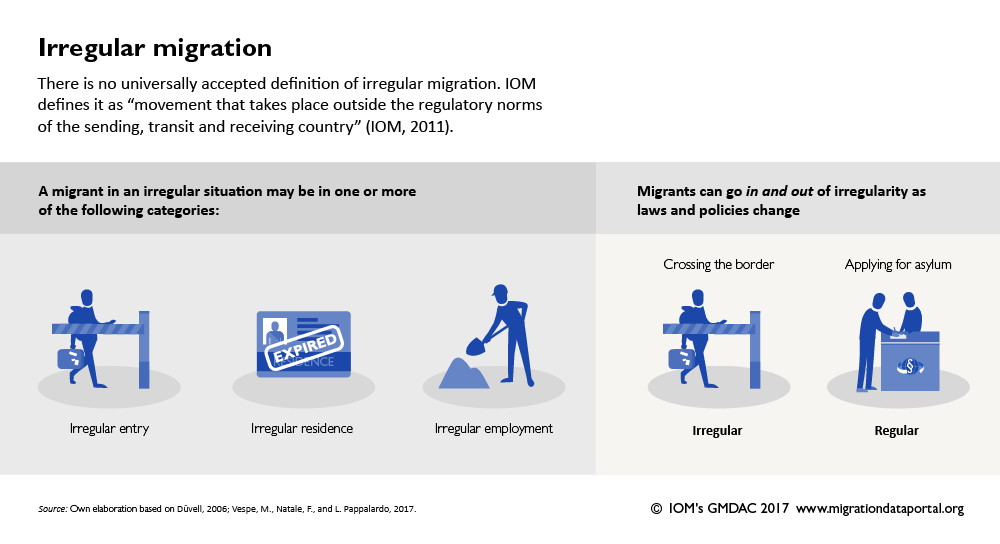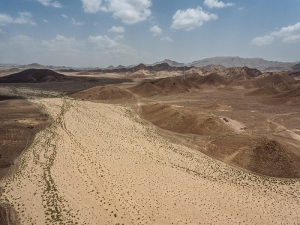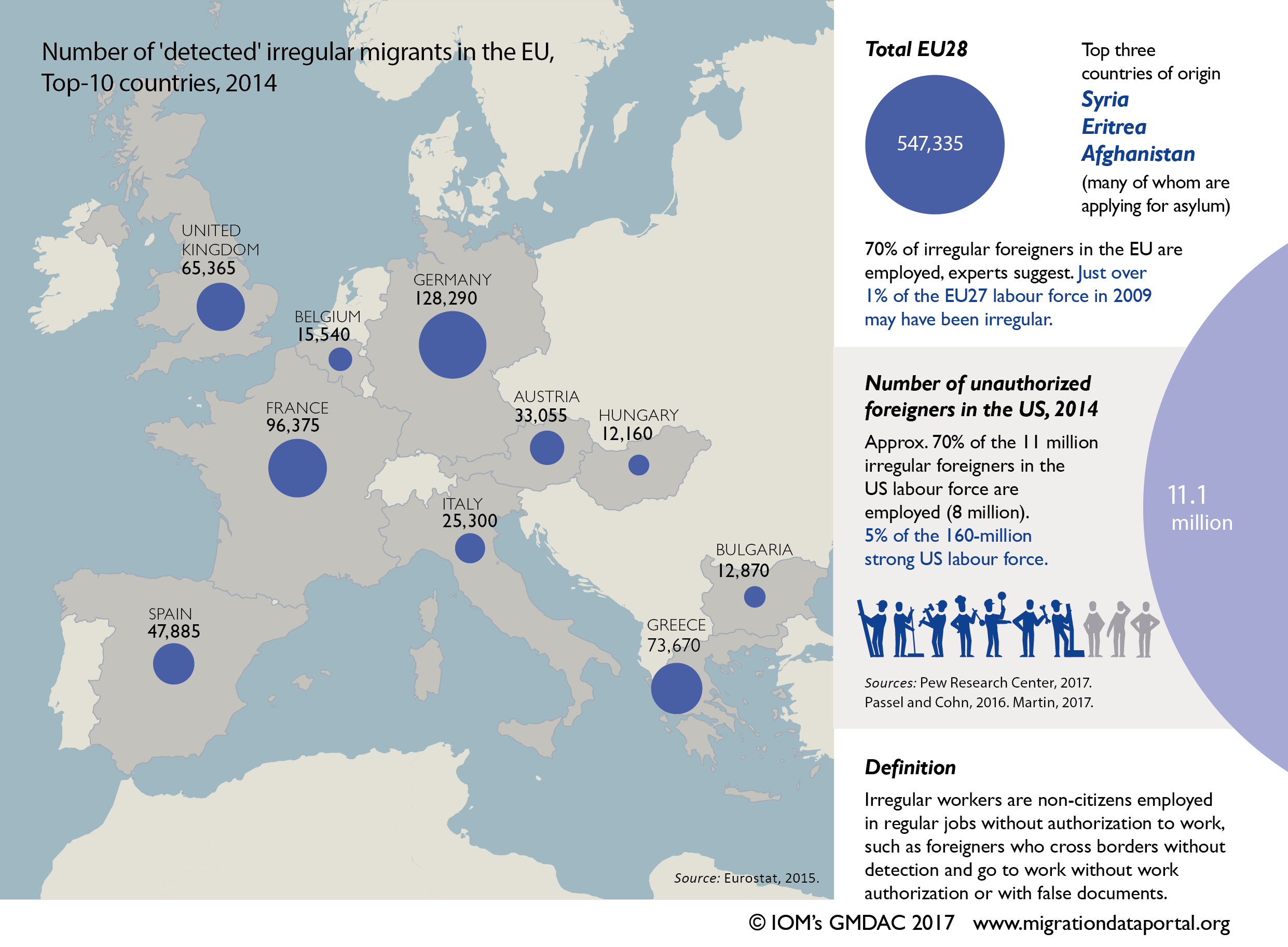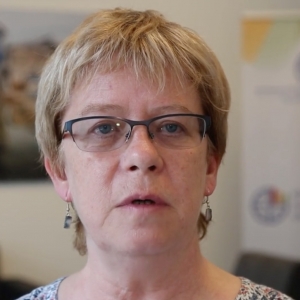International migration flows
Migration flows data capture the number of migrants entering and leaving (inflow and outflow) a country over the course of a specific period, such as one year (UN SD, 2017). Data on migration flows are essential for understanding global migration patterns and how different factors and policies in countries of origin and destination may be related to flows. However, in contrast to migration stocks data, estimates on migration inflows and outflows by country of origin and destination are not available at the global level. Currently, only 45 countries report migration flow data to the United Nations (UN DESA, 2015).
Migration flows data on migrants entering and leaving over the course of a given time period (usually a calendar year) are often confused with migration stock data which estimate all migrants residing in a country at a particular point in time (UN SD, 2017, emphasis added).

Definition
Migration flows “refer to the number of migrants entering or leaving a given country during a given period of time, usually one calendar year” (UN SD, 2017). However, countries use different concepts, definitions and data collection methodologies to compile statistics on migration flows. Definitions of who counts as an international migrant vary over time in the same country and across countries.
Recent trends
Due to the lack of comparable data in many regions in the world, it is difficult to describe global trends of migration flows. Annual, comparable migration flows data are largely limited to countries in the Organization for Economic Co-operation and Development (OECD). In 2016, the total number of permanent entries in OECD countries was approaching 5 million. After a strong increase at the turn of the century and a peak in 2007, permanent inflows in OECD countries fell sharply in 2008 and 2009, in response to the global financial crisis. Since 2011, migration flows have increased by almost 25 per cent from 4 million to almost 5 million (OECD, 2017). This increase is largely due to humanitarian migration to Europe. After the decline recorded in 2017 largely due to the drop in the number of humanitarian migrant inflows, migration flows to OECD countries started to rise again in 2018 and amounted to about 5.3 million new permanent immigrants (OECD, 2019). Global estimates based on census data suggest that 0.5 per cent – or approximately 37 million people – left their native country to live in another country between 2010 and 2015 (Abel, 2016).
Data sources and measurement
Statistics on migration flows are based on a variety of data sources depending on the country. Countries may calculate migration flows based on information from administrative sources, such as data derived from issuance of temporary or permanent residence permits and population registries, or they may use sample survey data. Some countries report data on annual flows to the UN Statistics Division (UN SD), who has a mandate to collect migration statistics, including on migration flows, from countries through the Demographic Yearbook data collection system. Some countries report data to OECD or the Statistical Office of the European Union (Eurostat) as well. OECD data on permanent migration inflows allow to distinguish between different types of migration flows including work, family and humanitarian migration (OECD, 2019). However, the number of countries reporting flow data is limited and the data are often not harmonized.
The UN Department of Economic and Social Affairs (UN DESA) has compiled data on the flows of international migrants to and from selected countries since 2005. The latest Revision, in 2015, contained data from 45 countries that collected this information (only 43 on emigration flows) – a steady increase compared to 15 countries in 2005, and 29 countries in 2008. Eurostat provides flows data disaggregated by age and sex, covering the EU-28, Iceland, Liechtenstein, Norway and Switzerland. In addition, UN SD provides statistics on international travel and migration through their Demographic Yearbook. These migration flows are disaggregated by reason for admission, purpose of staying or going abroad, age and sex. Raymer et al. (2013) also provide bilateral migration flows estimates by sex and age for European countries. Nawrotzki and Jiang (2015) estimated age and sex-specific bilateral net migration flows (the difference between migration inflows and outflows) around the year 2000; the information is contained in the publicly available Community Demographic Model International Migration (CDM-IM) dataset.
Given the lack of flow data at the global level, researchers have developed their own estimates of (bilateral) global migration flows based on 5-year intervals (see Abel and Sander, 2014; Raymer et al., 2013). These estimates are based on UN statistics on changes in migrant stocks over time. Statistics on bilateral migration flows are also available from the DEMIG Country-to-Country database (C2C) of the University of Oxford, which contains bilateral migration flows data for 34 countries, and from up to 236 countries for the period 1946-2011. The database also provides gender breakdowns where available and more historical depth.
The International Organization for Migration’s Displacement Tracking Matrix (DTM), a system to track and monitoring population displacement and mobility, collects migration flows data through flow monitoring component in more than 30 countries. DTM flow monitoring assesses areas of high mobility, often at key entry, exit and transit locations. Flow monitoring activities aim to derive quantitative estimates of the flow of individuals through specific locations and to collect information about the profiles, intentions and needs of the people moving. Tools used under this component include baseline assessments at national and local levels, flow monitoring registries and in-depth surveys.
Back to topData strengths and limitations
The quantification of migration flows is fundamental for the analysis of contemporary migration patterns, particularly the impacts of different factors and policies in countries of origin and destination. Inflow statistics compiled by OECD are available by category of entry, such as whether people moved for reasons of work (including seasonal workers), family reunification, humanitarian protection or others. Numbers of people moving within areas of free circulation such as the European Union or the Southern Common Market (Mercosur) are also indicated separately in the OECD’s International Migration Database.
However, the availability of international migration flows data are limited:
- Flow data are only compiled for 45 countries worldwide (UN DESA, 2015) or estimated by region.
- Those countries that do report flows often use different concepts, definitions and data collection methodologies which can make the comparison of flows across countries difficult.
- Flow monitoring tracks movement of people in and out of a country, but is limited in recording international migration, distinguishing one-way and circular migration, and using a systematic sampling frame.
- There are challenges associated with the use of administrative sources to derive statistics on international migration flows: such sources usually record events (e.g. issuance/renewal/withdrawal of a residence permit) and may not necessarily reflect actual migration movements (e.g. a residence permit is not renewed but the person stays in the country, or the permit is renewed but the person leaves the country).
Further reading
| United Nations Department for Economic and Social Affairs Statistical Division (UN SD) | |
|---|---|
| 2017 | Handbook on Measuring International Migration through Population Censuses. Background document. Statistical Commission, Forty-eighth session 7-10 March 2017, Item 4(a) of the provisional agenda, Demographic Statistics. UN, New York. |
| Global Migration Group (GMG) | |
| 2017 | Handbook for Improving the Production and Use of Migration Data for Development. KNOMAD, World Bank, Washington, D.C. |
| United Nations Department of Economic and Social Affairs (UN DESA) | |
| 2015 | International Migration Flows to and from Selected Countries: the 2015 Revision. |
| Organization of Economic Cooperation and Development (OECD) | |
| 2017 | International Migration Database. OECD, Paris. |
| 2019 | International Migration Outlook 2019. OECD, Paris. |
| Abel, G. J. and N. Sander | |
| 2014 | Quantifying global international migration flows. Science, 343 (6178):1520-1522. |
| Abel, G. J. | |
| 2016 | Estimates of global bilateral migration flows by gender between 1960 and 2015. Vienna Institute of Demography. Working Papers 2/2016 |
| Raymer, J., A. Wiśniowski, J. Forster, P. Smith and J. Bijak | |
| 2013 | Integrated modeling of European migration. Journal of the American Statistical Association, 108 (503): 801-819. |
| International Migration Institute (IMI) | |
| 2017 | DEMIC C2C Data. University of Oxford, Oxford. |
| Nawrotzki, R. J. and L. Jiang | |
| 2014 | Community Demographic Model International Migration (CDM-IM) Dataset : Generating Age and Gender Profiles of International Migration Flows. NCAR Technical Note NCAR/TN-508+STR, 41 pp, doi:10.5065/D6NS0RV2. |
| Abel, G. J., and K.C. Samir and N. Sander | |
| 2013 | Examining the Role of International Migration in Global Population Projections. Conference paper, Vienna. |
| Lemaitre, G., T. Liebig, C. Thoreau, P. Fron | |
| 2007 | Standardized statistics on immigrant inflows: results, sources and methods. OECD, Paris. |









